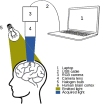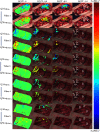Intraoperative quantitative functional brain mapping using an RGB camera
- PMID: 31890745
- PMCID: PMC6929684
- DOI: 10.1117/1.NPh.6.4.045015
Intraoperative quantitative functional brain mapping using an RGB camera
Abstract
Intraoperative optical imaging is a localization technique for the functional areas of the human brain cortex during neurosurgical procedures. However, it still lacks robustness to be used as a clinical standard. In particular, new biomarkers of brain functionality with improved sensitivity and specificity are needed. We present a method for the computation of hemodynamics-based functional brain maps using an RGB camera and a white light source. We measure the quantitative oxy and deoxyhemoglobin concentration changes in the human brain cortex with the modified Beer-Lambert law and Monte Carlo simulations. A functional model has been implemented to evaluate the functional brain areas following neuronal activation by physiological stimuli. The results show a good correlation between the computed quantitative functional maps and the brain areas localized by electrical brain stimulation (EBS). We demonstrate that an RGB camera combined with a quantitative modeling of brain hemodynamics biomarkers can evaluate in a robust way the functional areas during neurosurgery and serve as a tool of choice to complement EBS.
Keywords: Monte-Carlo simulations; RGB camera; functional brain mapping; hemodynamic response; intraoperative imaging; optical imaging.
© The Authors. Published by SPIE under a Creative Commons Attribution 4.0 Unported License. Distribution or reproduction of this work in whole or in part requires full attribution of the original publication, including its DOI.
Figures












References
-
- Penfield W., Boldrey E., “Somatic motor and sensory representation in the cerebral cortex of man as studied by electrical stimulation,” Brain 60(4), 389–443 (1937).BRAIAK10.1093/brain/60.4.389 - DOI
LinkOut - more resources
Full Text Sources
Other Literature Sources

